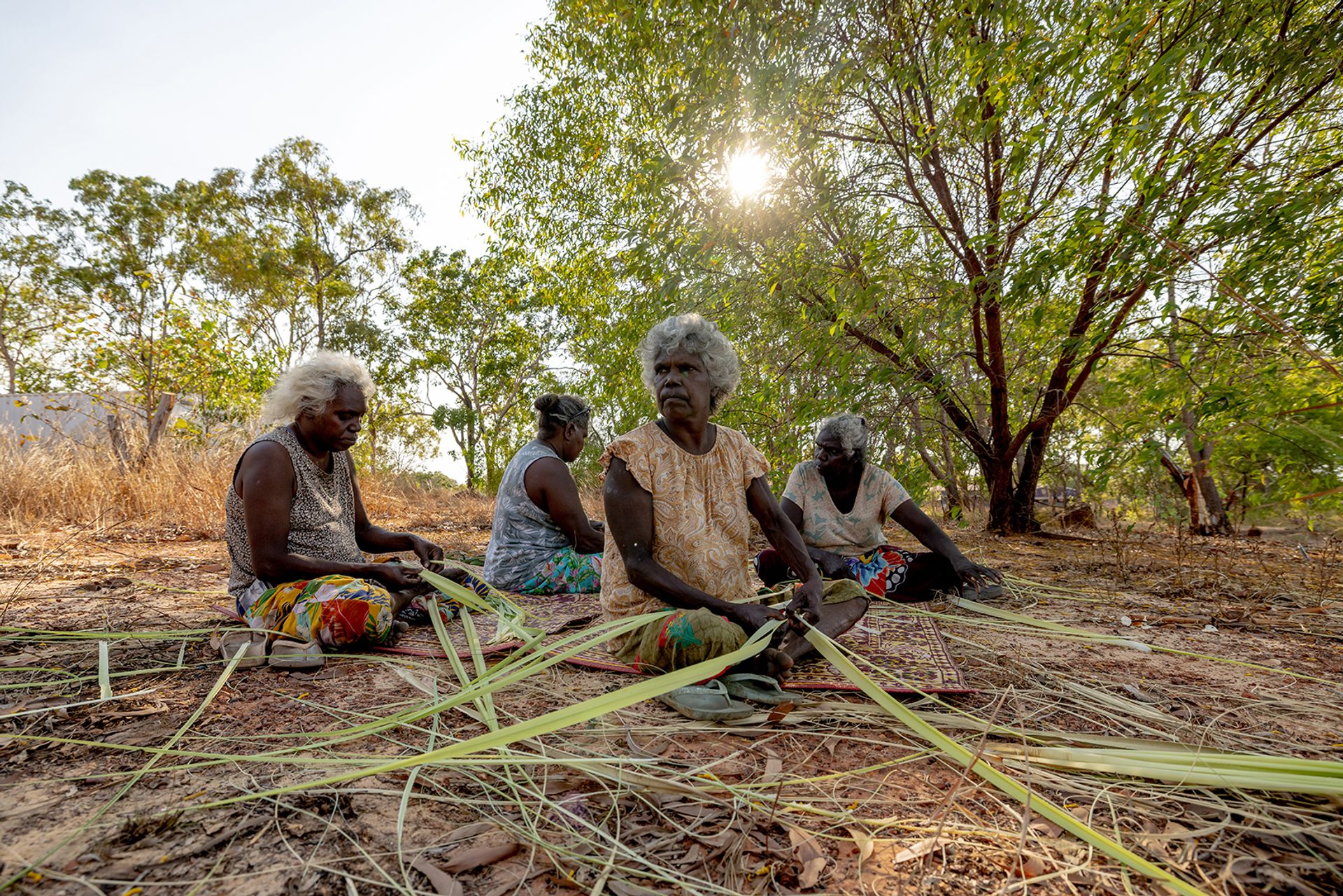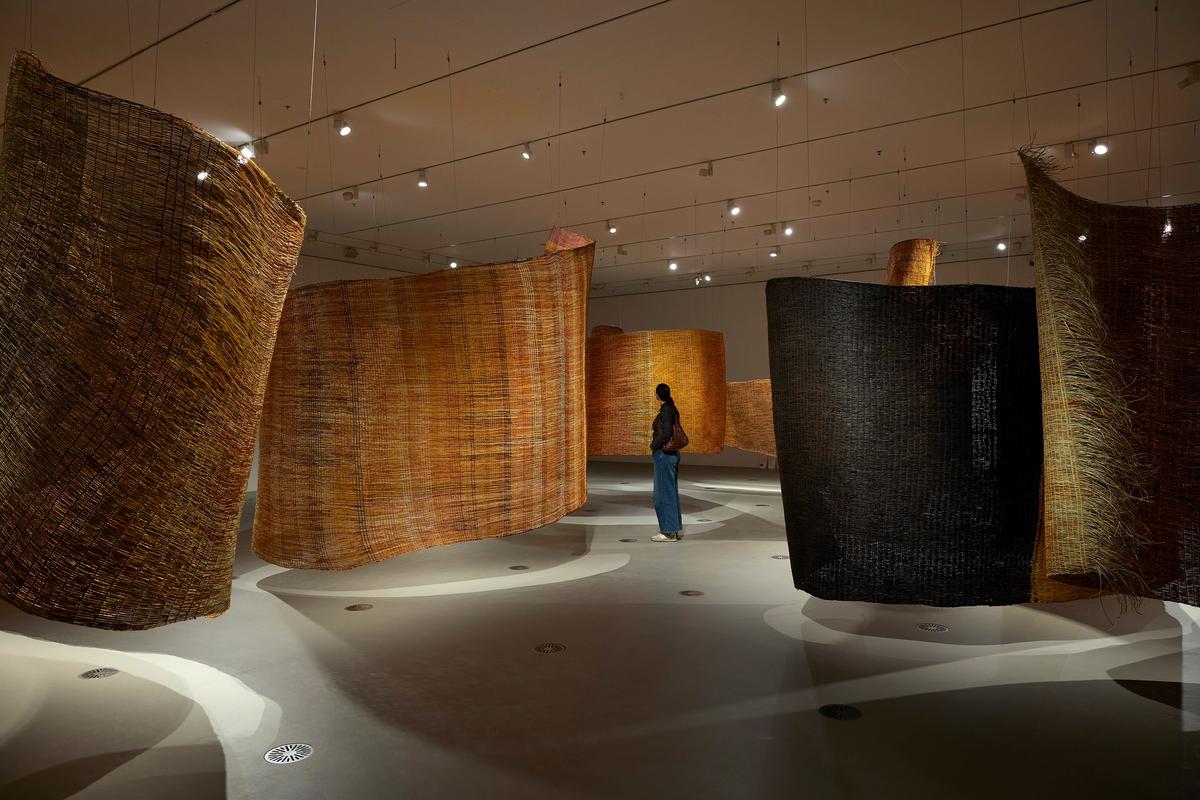The remote settlement of Maningrida on the monsoonal coast of Australia’s Northern Territory has been humming for two years with the creation of one of the world’s most ambitious weaving projects.
Mun-dirra, meaning “fish fence” in Burarra (one of a dozen Indigenous languages spoken in Maningrida), made its debut yesterday at the third NGV Triennial at the National Gallery of Victoria in Melbourne (until 7 April 2024). Yoko Ono, Yinka Shonibare and Tracey Emin are among the other 100 artists from more than 30 countries participating in the event.
Mun-dirra measures approximately 100m long. It was commissioned by the NGV, which has acquired the work for its permanent collection. The piece was created by ten women weavers who have each completed a 10m section of the fish fence. For millennia, in the creeks and rivers of Maningrida and its surrounds, fish fences were used together with conical fish traps.
In the 1970s, when Indigenous people adopted Western fishing methods such as the hook and line, fish fences began to be produced for purely artistic purposes, although they are still as strongly made as their forerunners.
As each weaver completed her 10m section of the fish fence, it was transported from Maningrida to Darwin, the Northern Territory capital, by barge, then 3,000km by air to Melbourne. Some of the weavers who worked on Mun-dirra live in Maningrida, while others live at Yilan, a small Indigenous community around 120km to the east.
Because the Top End of Australia is tropical and monsoonal, Maningrida and Yilan are reachable only by sea and air during the wet season, from November to April. Poor road access to remote communities was one of many issues at stake in Australia’s recent referendum to change the constitution to give Indigenous people a “voice to Parliament” on matters affecting them.
The federal government led by Labor Prime Minister Anthony Albanese championed the Voice—as the referendum was called—the idea for which sprang from the Indigenous community itself. But a months-long debate about the Voice turned bitterly political and divisive, and the referendum on 14 October was defeated by every state and territory in Australia, except the ACT (Australian Capital Territory), which comprises Canberra.
Canberra seemed very far from Maningrida when The Art Newspaper visited the settlement and met some of the Mun-dirra weavers in late September, just before the onset of the weather season.
Some of the women of Maningrida are renowned weavers who learned their skills from their mothers. They include Freda Wayartja Ali and Bonnie Burarngarra, who worked together to make an elegant fish-trap sculpture called An-gujechiya that won the 2022 Wandjuk Marika Memorial 3D Award at the National Aboriginal and Torres Strait Islander Art Awards.
Doreen Jinggarrabarra is a prominent artist who learned weaving from her mother Elizabeth Mipilanggurr (1935-2004). Lorna Jin-gubarrangunyja won the Wandjuk Marika 3D Memorial award in 2003 and has sold her weavings since the 1980s. The other principal artists on the project are Freda Ali (known as Freda #2), Maureen Ali, Gabriella Garrimara, Indra Prudence, Jennifer Prudence and Zoe Prudence. Cecille Baker, Michelle Baker and Anthea Stewart assisted, as did various family members who are learning to weave.
Foray into the forest
Careful to avoid snakes, scorpions and stinging green ants, The Art Newspaper accompanied Lorna Jin-gubarrangunyja, her daughter Freda #2, Cecille Baker and Michelle Baker into the forest 2km east of Maningrida where the women collected pandanus leaves for the Mun-dirra weaving.

Left to right: Michelle Baker, Freda Ali, Freda Wayartja Ali and Cecilia Baker, four of the ten principal weavers of Mun-dirra, prepare pandanus for dyeing Renae Saxby
“It’s hard work, eh?” Jin-gubarrangunyja says over her shoulder, as the midday heat presses down. Three hours later and the women have collected heavy bundles of pandanus leaves wrapped in paperbark. The pandanus will be sun-dried for about 20 minutes before being dyed. The women collect leaves and roots for dyeing, including the bulbous red root of the bloodroot (Haemodorum coccineum), which produces a rich pink colour when boiled in water.
After the dyeing process, the women sit on the ground to weave. Despite what must be backbreaking work, they say that they love what they do and are proud that their skills are being handed down to the next generations.
The weaving style of each woman reflects her personality, according to Brooke Ainscow, the manager of Maningrida Arts and Culture, the art centre that coordinated the Mun-dirra project in collaboration with the NGV curator Myles Russell-Cook.
I look at the weavings and I know who did it. Everyone has their subtle differences in how they weaveBrooke Ainscow, Maningrida Arts and Culture
“I look at the weavings and I know who did it,” Ainscow says. “Everyone has their subtle differences in how they weave.”
Because plants yielding different dyes are harvested at different times of year, the graduated colours of the weavings reflect the changing seasons. The colours are reds, yellows, browns, black and green. Some areas are also left undyed. “The pink colour that gets used a little bit only grows in the wet season,” Ainscow says.
Maningrida Arts and Culture is one of Australia’s most successful Indigenous arts centres, representing artists such as the bark painter John Mawurndjul, who was commissioned to paint a ceiling at the Jean Nouvel-designed Musée du Quai Branly—Jacques Chirac in Paris when it opened in 2006. Russell-Cook says Mun-dirra is the largest woven sculpture ever produced in Australia.
Despite the distance between Maningrida and the NGV, many of the ten weavers including Freda Wayartja Ali and Lorna Jin-gubarrangunyja plan to make the journey for the Triennial opening events. Standing with their pandanus bundles at their feet in the bush, the women say they are looking forward to it.


